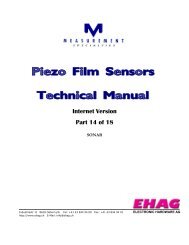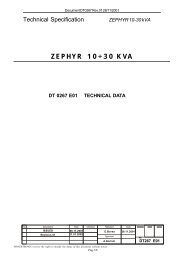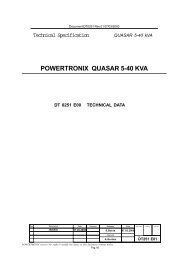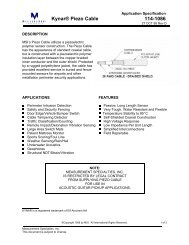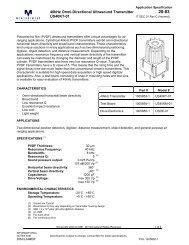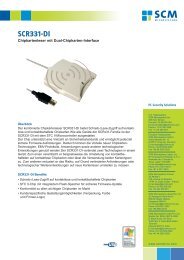Roadtrax BL Traffic Sensors - EHAG Electronic Hardware AG
Roadtrax BL Traffic Sensors - EHAG Electronic Hardware AG
Roadtrax BL Traffic Sensors - EHAG Electronic Hardware AG
You also want an ePaper? Increase the reach of your titles
YUMPU automatically turns print PDFs into web optimized ePapers that Google loves.
Measurement Specialties Inc, Sensor Products Division,<br />
<strong>Roadtrax</strong> <strong>BL</strong> <strong>Traffic</strong> <strong>Sensors</strong><br />
Revised October 2001<br />
Installation hints for the MSI <strong>BL</strong> sensor when using<br />
Global Resin PU 200/PU260 Resin, IRD AS475 and other low viscosity<br />
installation materials.<br />
Layout and mark the location of the sensors on the road. The sensors should be exactly<br />
perpendicular to the flow of traffic. Position the sensor in the left side of the wheelpath, with<br />
the lead attachment of the sensor toward the cabinet. The end of the sensor should be all the<br />
way to the edge of the lane.<br />
Cut a slot for the sensor 3/4" wide ( 1/16") and 1" deep ( 1/4"). The slot should be 8" longer<br />
than the sensor. Wet cut the slot with a diamond blade.<br />
Cut the lead in cable slot centered on the sensor slot. The lead in cable slot should be a<br />
minimum of 2" deep and 1/4" wide. If conduit or tubing is used for the lead in cable, the slot<br />
should be 1/8" wider than the conduit.<br />
Sweep and powerwash with fresh water to clean the slots. Dry them compressed air, natural<br />
evaporation or heaters, depending on weather conditions.<br />
Place a stip of duct tape along the edge of the slot. The duct tape should not overlap into the<br />
slot; it can be up to 1/8" away from the slot.<br />
Remove the sensor from the box. Do not set the sensor on the road. Check to see that the<br />
sensor is straight and flat, with no twists or curls. Straighten the sensor if necessary.<br />
Use an LCR Meter, measure the capacitance, resistance and dissipation factor of the sensor.<br />
Use the 20nF setting for capacitance and dissipation tests and the 20MΩ setting for the<br />
resistance test. Record all results. All capacitance reading should be within � 20% of the<br />
readings on the data sheet provided with each sensor.<br />
Clean the length of the brass element of the sensor with steel wool or an emory pad. Place<br />
the installation brackets on the sensor every 6" ( 1"). Make sure all of the brackets are facing<br />
the same direction.<br />
Slightly bend down the end of the sensor at a 30° angle. Slightly bend down the sensor at the<br />
lead attachment at a 15° angle. Then bend it back level, forming a lazy Z.<br />
Position the sensor in the slot. Start at the end of the sensor and set the clips into the slot.<br />
The end of the sensor should be 3" from the center line/edge of the road.<br />
Press down on the top of the brackets so that they are just below the road surface.<br />
Using a locally made jig or a combination square, press down on the top of the sensor near<br />
the installation bracket so that the top of the sensor is exactly 3/8" below the road surface and<br />
the top of the brackets are 1/8” below the surface of the road.<br />
Use two pieces of backer rod, 2" diameter and about 6" long to seal the home run slot<br />
beyond the location of the lead attachment. The backer rod should be positioned on both<br />
sides of the passive cable, 3" past the end of the lead attachment. Place the passive cable<br />
into the slot, ensuring that it goes all the way to the bottom of the slot. The cable itself should<br />
be positioned in the midpoint of the slot.<br />
If tubing or conduit is used for enclosing the home run cable, it should stop on the far side of<br />
the backer rod.<br />
Visually check the positioning of the sensor. It should be at the same depth along the entire



